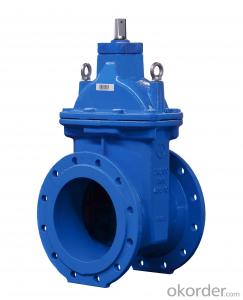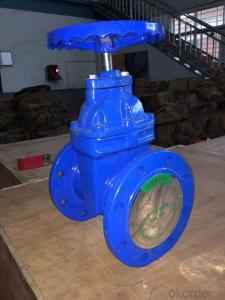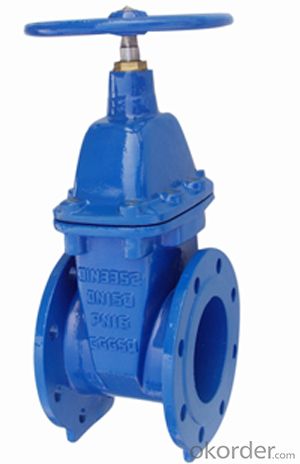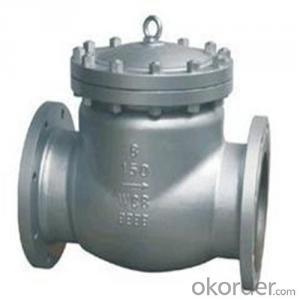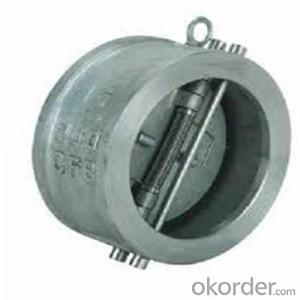Non-rising Stem Metal Seated Gate Valves Made of Ductile Iron
- Loading Port:
- Tianjin
- Payment Terms:
- TT OR LC
- Min Order Qty:
- 100 unit
- Supply Capability:
- 100000 unit/month
OKorder Service Pledge
OKorder Financial Service
You Might Also Like
Non-rising resilient seated gate valves solve the problem in general gate valves such as leakage, rusting etc. and saves installation space. It is used widely in tap water industry, sewage treatment, shipping construction, petroleum, chemicals, food, pharmacy, textile, electric power, metallurgy and energy system's pipeline to adjust and shut off fluids.
l Replaceable O-ring
l Low torque operation
l Rubber encapsulated wedge
l Clockwise closing direction
l Fusion bonded epoxy coated inside and outside
Specification
Body materials: Ductile Iron/Metal
Design standard: DIN3352 F5/F4, according to requirements
Design pressure: PN10/PN16/PN25
Size: DN80mm-DN2000
Connect type: Flanged gate valve
Seal type: Resilient seated gate valve, EPDM+ Ductile Iron
Coating:
Fusion bonded epoxy coated both on the interior as well as the exterior surfaces of the valve, flange surfaces are also fully epoxy coated, blue color.
Application
Potable water, neutral liquids, irrigation, heating and chilled water, fire systems etc, in either above ground or buried service applications and requires minimal maintenance
Feature
This Ductile Iron Resilient Seated Gate Valve is fully compliant to DIN3352 F4. We have light weight type, heavy weight type and even middle weight type for your reference, and these three options design construction of ductile iron will offer a robust and durable extended life performance.
1- Bolted bonnet, full bore: used for larger valves and higher pressure applications.
2- Stem sealed with O-rings: realize zero leakage, could be replace under full pressure.
3- Rubber encapsulated wedge: excellent elastic memory, ensure sealing effect.
4- Blue fusion boned epoxy coated inside and outside: suitable for portable water.
5- Working pressure from -1 to +16 and working temperature from -10 to +80°C
Durable
This valve is suitable for use in a wide range of applications including potable water, neutral liquids, irrigation, heating and chilled water, fire systems etc, in either above ground or buried service applications and requires minimal maintenance. This Resilient Seated Gate Valves have a rated working pressure of 16 Bar. The valves seal 100% leak tight. The waterway is clear, unobstructed and free from pockets. Resilient seated gate valves are fusion bonded epoxy coated both on the interior as well as the exterior surfaces of the valve, flange surfaces are also fully epoxy coated.
Advantages
1- OEM Factory : Professional manufacturer, clients from whole world.
2- High Quality, Competitive Price: Custom is accepted.
3- Complete Service: Long service Life, Fast delivery, Multilingual services.
4- Certificates: ISO9001, CE, NSF, TS, WRAS.
5- Low MOQ: Ready for providing the sample and producing some small orders.
FAQ
Q: Do you produce valves with PN40?
A: Yes, but for PN40, we suggest materials of metal, like cast steel, stainless steel…etc. We could also produce ductile iron valves with PN40.
Q: Are you manufacturer or trading company? Which kind of valves do you supply?
A: We are a professional manufacturer of butterfly valves, check valve, non-return valves, gate valves, Y-strainer and so on.
Q: Will you do inspection before shipment? Whether Third Party Inspection is available?
A: We have a professional engineer team, so we can offer you the most professional technical support. All valves are tested twice before and after hammer pin to ensure its perfect sealing property and to make sure every valve is ok before ex-factory. TPI is ok but the clients should bear all fees.
Q: What kind of package do you use for these valves?
A: Valves from DN80-DN1400 will be packed in wooden boxes, but valves above DN1400 will be in wooden pallets. If you need wooden boxes for above DN1400, the price may be more expensive.


- Q: I accidentally pushed the pressure release valve on my hot water heater last night. It ran for a while, and did not stop. I turned the water off, the valve on the cold water piper above the water heater, and it stopped running. Will this stop running at some point? The overflow tray fills too quickly for me to drain it. When I turn the water back on it starts pouring out again. HELP!!!
- After long periods of inactivity, mineral deposits will form on the pressure side of the valve. When you pushed the valve some of the deposits likely lodged in the valve preventing it from closing all of the way. The good news is that you need not replace your water heater. The bad news is you will likely need a new valve. It is important to replace the valve in these situations because the same mineral deposits that prevent it from closing now can also prevent it from opening when it is needed to relieve excess pressure.
- Q: I have a yamaha cornet and i took the valves out to oil them. i put the valves in, and now only the middle on makes a sound. when i put down no valves, and doesn't make a sound, only when i press down valve two. i think it is the way i put the valves because it has those holes. can some one let me know what is the right way to put the valves in, like explain or show me a video. thanks.
- I play a baritone, but I hope I can help. On my instrument there are little notches at the tops of the valves. I had to spin my valve until I heard a slight click then I would push down on the valve to make sure it worked. (I would start on the first valve) Then to make sure that I had it in right I would blow in the instrument to see if the air went through the holes. Try that, it might help. Also, the next time you take your valves out keep them in order and in the position they came out in.
- Q: Ok I recently changed my pcv valve and today when I was checking my spark plugs I noticed and valve that looked exactly like a pcv valve on the passenger side valve cover iam not sure exactly what this valve is ?? I should note that I changed the pcv valve on the driver side because I noticed that it was just a hose coming out of a rubber grommet and into the back of the carb was that just a breather hose ? Thanks in advance for any info
- That other one is the crankcase breather, it goes to the air cleaner with a small clear plastic filter by the main air filter. It's not a valve so changing the breather filter is all that need be done with it.
- Q: Water has been seeping out of the sprinklers closest to the anti-siphon valve. Water seeps out of the sprinkler even when the anti-siphon valve is manually closed and not connected electronically. I opened up the anti-siphon valve to inspect the diaphragm, but there is no debris nor it was damaged. To be sure, I switched the diaphragm chamber of the two anti-siphon valves (a suspected leaky one and another good working one), but leak persists from the same sprinklers. I think the leak is from the (float?) rubber seal at the bottom of the stem closing the inlet valve. My anti-siphon is a Hardie (or Irritrol) model 311A series.1) Is my troubleshooting and logic correct? What other components could have contributed to the leak described? 2) At what scenario will water be flowing out of the anti-siphon cap?3) How can I determine if my anti-siphon valve has a vacuum breaker? What is a vacuum breaker good for?4)Which brand makes the most reliable anti-siphon valve?
- I work in a printing plant,and our city mandates anti-siphon valves on all our commercial equipment,so I have a little knowledge about these.We used to call these pesky creatures Vacumn Breakers,but now they are called anti-siphon valves,but what's in a name-they both are supposed to accomplish the same thing.Should your water pressure drop,due to a broken main or largefire,these devices are supposed to prevent contaminated water,like the contents of the Agfa Encomatic plate processor rinse tank,or your irrigation pipes,from being pulled back into your plumbing ,and then out your faucets when pressure is restored ,which could make everybody sicker than pooches. The way these work on industrial models is a little more complicated,but the principle is the same,for water to flow through the system,a certain pressure must be maintained.Our older models had a spring and diaphram arragement,the water pressure pushed the diaphram against a seal seat,with a spring behind it.As long as the pressure in the valve was greater than the spring,water would flow through the vave,but when the pressure ceased,the spring closed the diaphram,which in turn opened a vent that allowed the water to drain hence,vacumn breaker.These had to be at a point above the turn-offs,by the way,and when they malfunctioned,due to debris or rusted springs,they could either fail,and stay open,or fail,and water wouldcome gushing out the cap. The conditions you desribe sounds like a low pressure situation,where there is not enough pressure to flow through the anti-siphon.Is your supply line kinked or crushed?
- Q: I just dropped my 3rd valve slide from my trumpet on the ground. It fell with the curved end first. I can't see any dents and it doesn't look bent, but I oiled it and everything and it's really hard to move. Could it be bent? How can I fix it?
- Be sure that it is aligned correctly when you place it back in the valve casing. When you are putting it back in, it has to turn until you hear a click, indicating that the valve guide has fallen in the right space. This aligns the valve with all the ports. (The valve guide is a small plastic piece located under the valve spring. This valve guide must snap into a little notch inside the casing. When it does, the valve will be perfectly aligned. You will know when the valve guide is in the right place because you will feel and hear a click and the valve will not rotate any longer.) After thorough cleaning, oiling, and correct valve placement, if you still notice it sticking, take it to a repair shop to have it chemically cleaned. They are typically very good and will ensure your trumpet is in proper playing condition.
- Q: the pressure relief valve on the top of the tank needs replaced
- strictly speaking there are qualifications for this kind of repair hot pressurised water can be very dangerous
- Q: How do you remove a richdel sprinkler valve, when I turn the body of it, it doesn't unscrew, it just turns in place.
- is it the valve your trying to remove, or the sprinkler head? if its the valve, there will be two pipes, one in and one out, just unwind the thread at end end of the valve, If its the sprinkler itself, then there should be a pipe under the sprinkler(swing joint) just grab the whole body and unscrew ( make sure you grab the whole sprinkler and not just the top, you may have to dig around it
- Q: I drive a 08 lancer and I want to add a SRI. Can I produce the blow off valve sound like a turbo?
- yes but it wont sound as crisp but it will have that same ingredient
- Q: I just bought my first bike in 20 years, and as a result have had to pump up a bike tire for the first time in 20 years. I was dazzled to discover a type of tire valve that I'd never known about. The Presta.So of course, I need a pump with a special adapter, I didn't know to unscrew that nut at first so I accomplished a whole lot of nothing for awhile, and once I did open the nut, the pump kept slipping off the tire once I got anywhere near the tire' recomended PSI until I awkwardly held it in place while operating my pump with one hand, which of course meant less leverage and so while I got above the min recommended PSI, I couldn't get anywhere near the upper end of the spectrum. Why would anyone use these ridiculous contraptions? The fact that they are used means there must be some rationale. A brief internet search seems to find more forum posts with people saying the alternative (Schraeder) valves are more reliable and don't leak as much either.Educate me!
- I've never had any problems with presta valves. I suppose their only advantage is that they can be fitted on ultra thin rims.
- Q: Please suggest some design or sketch giving details of its operation. I need to operate valves on a natural gas pipeline with actuators to sense and operate the valve after recieving the signals from level switch in the system. Please help me understand the mechanism and operation philosophy.Please also suggest your email address as I may have to revert for subsequent questions on the same. Your addresses will be safe here and won't be passed on to any undesired sites. Be rest assured.
- Valve actuators are of various types namely electrically operated , pneumatically operated. Pneumatically operated actuators can be diaphragm operated for globe , gate valves. Pneumatic actuators can be quarter turn type for ball or butterfly valves. Pneumatic actuators can be cylinder operated for say Knife gate valves. Actuators are again single acting spring return type or double acting. Again actuators can be classified as on-off type or control ( modulating type). On- off pneumatic actuators can be operated with solenoid valves . As you mention the fluid to be natural gas, you have to select solenoid valves which are intrisically safe at the same time these valves may be placed at a safe distance from the valves and piping. These valves are again actuated by controllers( on -off , PID) connected to the level switches, pressure sensors or temp sensors as the case may be. To control flow rates, you need to use a pneumatic control valve with a pneumatic positioner operating on (0.2-1 kg/cm2) with current to pressure convertor or an electroneumatic positioner ( 4-20mA control signal). These can be used to control flow rate or downstream pressure. Other elements required are pressure or flow sensors, PID controllers. The control again depends on how the plant is operated ie DCS or PLC controlled. If it a simple requirement then the actuatar can be made to operate on a system of limit switches. While selecting an actuator the fail safe mode ( in case of power, signal or air failure) should also be taken into consideration , which is specified by words like normally open or normally closed etc. Avoid electric actuators as the gas is inflammable as a particular case.
Send your message to us
Non-rising Stem Metal Seated Gate Valves Made of Ductile Iron
- Loading Port:
- Tianjin
- Payment Terms:
- TT OR LC
- Min Order Qty:
- 100 unit
- Supply Capability:
- 100000 unit/month
OKorder Service Pledge
OKorder Financial Service
Similar products
Hot products
Hot Searches
Related keywords
